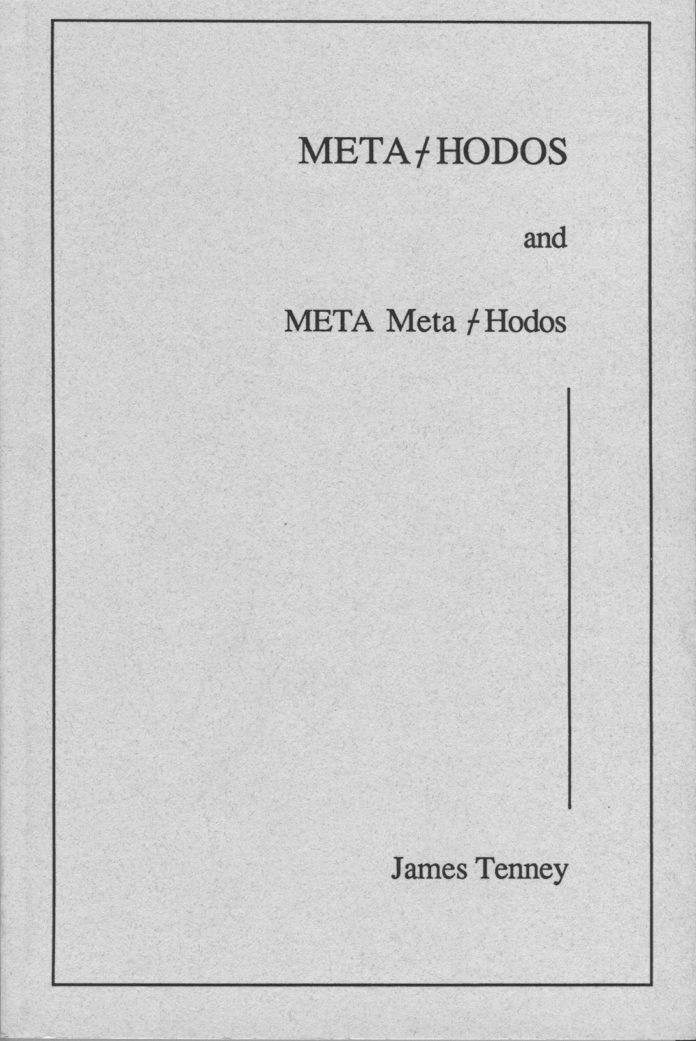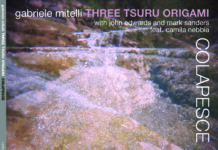Composer James Tenney’s Meta+Hodos was an early formulation of what he described as a “conceptual framework for musical description and analysis.” Tellingly, Tenney chose as his title an etymological breakdown of the word “method,” showing its roots in the Greek μετά(“after”) and ὁδός (“way”). Fifty years after it first appeared in print, the book remains a thought-provoking, methodical analysis of the experience of perceiving music.
Tenney (1934-2006), who was a performer as well as a composer, wrote early computer music based on information theory and later wrote for conventional instruments using just intonation and alternate tunings. He also had a substantial interest in currents of thought outside the field of music, as Meta+Hodosdemonstrates. Written in 1961 as a Master’s degree thesis and published in 1964, Tenney’s essay is a systematic application to musical analysis of concepts derived from phenomenology and Gestalt psychology.
From Clang to Sequence to Form
Tenney’s basic concept is something he calls “the clang”—a sound or complex of sounds that the hearer perceives as a primary musical or aural unit. Grounded in psychologist Kurt Koffka’s idea of the perceptual gestalt, the clang is an essentially phenomenological concept, which is to say that it is meant to describe the way external stimuli—such as, for example, vibrations in the air—are experienced as meaningful structures. For Tenney, the clang’s function as a perceptual unit provides the groundwork that ultimately allows him to describe and analyze musical works in terms of their shapes or structures.
It is important to note that the clang as a musical unit encompasses not only tone, but other qualities of musical sound such as timbre and texture. This expansive conception of musical sonority is a reflection of the situation of art music in the middle of the 20thcentury, when musical ideas had become centered not only on pitch and harmony but on other, previously subordinate dimensions of sound. The clang thus provides for cases where a musical unit will be shaped not by pitch or harmony alone or even predominantly, but by any of these other factors instead.
Once this musical unit is established Tenney goes on to identify and analyze the formal factors by which musical units can be recognized and ordered into larger complexes. Borrowing again from Gestalt psychology, this time from Max Wertheimer, Tenney proposes temporal placement and aural resemblance or non-resemblance as the primary factors allowing listeners to perceive individual musical events as belonging together in sequences or standing separately as independent units. Musical events occurring closely in time and/or sounding alike will be taken (or heard) as belonging together; conversely, musical events separated by substantial pauses and/or not sounding alike will be perceived as being independent of each other.
Supplementing these primary parameters are the four secondary factors of intensity, repetition and what Tenney, drawing again from Wertheimer, calls “objective set” and “subjective set.” The first two of these factors help the listener to establish boundaries between musical events, while the second two allow the listener to hear relationships between musical events separated in time. A particularly intense passage will be perceived as the focus or initiation of a clang, thus providing a means of delimiting the clang as a unit. As does repetition: a melody, set of notes, rhythm, etc. that repeats will be taken as a unit in itself. Objective and subjective sets, on the other hand, have to do with the listener’s expectations regarding the way that musical compositions or performances develop. Subjective set describes the set of expectations a listener brings to any piece of music, based on, for example, his or her prior listening experiences and background knowledge about music and music history. Objective set describes the expectations the listener forms of a specific piece of music based on the piece’s internal qualities. A piece of music written according to common practice harmony, for example, would set up certain expectations in the listener about how the piece will develop as manifested in the sound patterns set up by the functional relationships among chords. The importance of subjective set and objective set lies in the way they relate musical events to each other in time, particularly to the extent that an earlier event will be perceived as having had an influence on a later event.
Having described the basic musical unit and its ordering into sequences, Tenney moves on to consider the question of the perception of larger-scale musical form. The basic idea is that form can be known through a grasp of a musical work’s constituent parts and of the relationships among those parts that, taken together, make up the work’s structure. Tenney postulates that the recognition of form arises from the listener’s perception of the differences in pitch, register, dynamics, intensity and so forth that arise over the course of the work. These differences will be heard as cues signaling the boundaries of musical units and groupings and will allow the listener to hear the relevant patterns linking and separating clangs and sequences. In this way the work can be resolved into the formal units which give it its musical configuration and cohesion.
From the phenomenological point of view put forth by Tenney, then, we hear music the way we do because of the way it is—divided into larger and smaller units relating to each other by virtue of their qualitative similarities and differences.
Analysis beyond Pitch
Although it takes into account conventional categories of music analysis, Tenney’s framework doesn’t limit itself to conventional musical analysis. Nor is it meant to. In a late interview Tenney claimed that his was a “colloquial phenomenology” interested in understanding what listeners actually notice rather than in an “overemphasis on the notes, specific intervals” and other technical musical details at play in a composition. And in fact the categories outlined in Meta+Hodosdo prove useful as a vocabulary for understanding how music functions, as demonstrated by Tenney’s effective analyses of musical examples from work by Ives, Varese, Schoenberg and Webern. And yet Tenney’s framework is also germane to new music that draws on a palette of sound and a repertoire of organizational principles significantly different from those of the examples he analyzes. While radical, these latter works are still essentially based on relationships of pitch and harmony; by contrast, much contemporary experimental music is music of timbre and texture, of unpitched sounds and silence.
Consider in this context the concept of the clang. As Tenney points out, an adequate description of a clang’s features will include, in addition to pitch and register, any and all other parameters that can be perceived as undergoing changes as the clang unfolds. Thus by definition the clang as an analytical tool accommodates itself easily to compositions made primarily or even exclusively of sound material that falls outside of traditional musical categories. As such, it lends itself to the analysis and understanding of compositions that would be virtually incomprehensible to conventional musical analysis. Similarly, Tenney’s definition of form as shape or structure, which is explicitly acknowledged to have an affinity with extra-musical definitions of form, fits sound-centered music organized according to contrasts of timbre, density, saturation, and other non-conventional compositional sound materials. Hearing these works in terms of their perceptual shapes would be one way to reveal the continuities and formal relationships that would likely escape an ear attuned to pitch and functional harmony.







